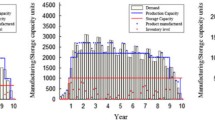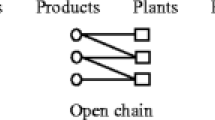Abstract
The foundry is an industry whose demand varies rapidly and whose manufacturing process is quite complicated. This paper explores issues on mid-term capacity planning in the foundry. First, issues on capacity planning of the foundry are categorized. Second, focusing on multi-site planning, an increment strategy for the number of auxiliary tools—“photo mask”—is proposed to increase the flexibility of production. The related decisions include how to allocate appropriately the forecast demands of products among multiple sites and how to decide on the production quantities of products in each site after receiving customer-confirmed orders. By constructing the mathematical programming model of capacity planning, the rates of capacity utilization and customer order fulfillment are found to be effectively enhanced by adding new masks to increase production flexibility. Furthermore, from the sensitivity analysis, the importance of customers is shown to influence significantly the amount of reserved capacity of customers. Increasing the number of certified factories is also an indirect way to increase capacity. For long life cycle products, the verification of products in multiple factories in order to increase capacity utilization rate effectively is suggested.
Similar content being viewed by others
References
Karabuk S, Wu SD (2003) Coordinating strategic capacity planning in the semiconductor industry. Oper Res 51(6):839–849
Hopp WJ, Spearman ML (2008) Factory physics: foundations of manufacturing management, 3rd edn. McGraw-Hill, New York
Liang YY, Chou YC (2003) Option-based capacity planning for semiconductor manufacturing. 2003 IEEE International Symposium on Semiconductor Manufacturing, pp. 77–80
Chou YC, Cheng CT, Yang FC, Liang YY (2007) Evaluating alternative capacity strategies in semiconductor manufacturing under uncertain demand and price scenarios. Int J Prod Econ 105:591–606
Li S, Tirupati D (1994) Dynamic capacity expansion problem with multiple product: technology selection and timing of capacity additions. Oper Res 42(5):958–976
Rajagopalan S (1998) Capacity expansion and equipment replacement: a unified approach. Oper Res 46(6):846–857
Rajagopalan S, Swaminathan JM (2001) A coordinated production planning model with capacity expansion and inventory management. Manag Sci 47(11):1562–1580
Swaminathan JM (2000) Tool capacity planning for semiconductor fabrication facilities under demand uncertainty. Eur J Oper Res 120:545–558
Swaninathan JM (2002) Tool procurement planning for wafer fabrication facilities: a scenario-based approach. IIE Trans 34:145–155
Wang KJ, Lin SH (2002) Capacity expansion and allocation for a semiconductor testing facility under constrained budget. Prod Plan Control 13(5):429–437
Wang KJ, Hou TC (2003) Modeling and resolving the joint problem of capacity expansion and allocation with multiple resources and a limited budget in the semiconductor testing industry. Int J Prod Res 41(14):3217–3235
Wang KJ, Wang SM, Yang SJ (2007) A resource portfolio model for equipment investment and allocation of semiconductor testing industry. Eur J Oper Res 179:390–403
Uribe AM, Cochran JK, Shunk DL (2003) Two-stage simulation optimization for agile manufacturing capacity planning. Int J Prod Res 41(6):1181–1197
Zhang Z, Zhang MT, Niu S, Zheng L (2006) Capacity planning with reconfigurable kits in semiconductor test manufacturing. Int J Prod Res 44(13):2625–2644
Hood SJ, Bermon S, Barahona F (2003) Capacity planning under demand uncertainty for semiconductor manufacturing. IEEE Trans Semicond Manuf 16(2):173–280
Catay B, Erenguc SS, Vakharia AJ (2003) Tool capacity planning in semiconductor manufacturing. Comput Oper Res 30:1349–1366
Christie RME, Wu SD (2002) Semiconductor capacity planning: stochastic modeling and computational studies. IIE Trans 34:131–143
Papageorgiou LG, Rotstenin GE, Shah N (2001) Strategic supply chain optimization for the pharmaceutical industries. Ind Eng Chem Res 40:275–286
Yilmaz P, Catay B (2006) Strategic level three-stage production distribution planning with capacity expansion. Comput Ind Eng 51:609–620
Lim SK, Kim YD (1999) An integrated approach to dynamic plant location and capacity planning. J Oper Res Soc 50(12):1205–1216
MirHassani SA, Lucas C, Mitra G, Messina E, Poojari CA (2000) Computational solution of capacity planning models under uncertainty. Parallel Comput 26(5):511–538
Ayuso AA, Escudero LF, Grain A, Ortuno MT, Perez G (2003) An approach for strategic supply chain planning under uncertainty based on stochastic 0–1 programming. J Glob Optim 26:97–124
Santoso T, Ahemd S, Goetschalckx M, Shapiro A (2005) A stochastic programming approach for supply chain network design under uncertainty. Eur J Oper Res 167:96–115
Geng N, Jiang Z (2009) A review on strategic capacity planning for the semiconductor manufacturing industry. Int J Prod Res 47(13):3639–3655
Bermon S, Hood SJ (1999) Capacity optimization planning system. Interfaces 29(5):31–50
Bard JF, Srinivasan K, Tirupati D (1999) An optimization approach to capacity expansion in semiconductor manufacturing facilities. Int J Prod Res 37(15):3359–3382
Chung SH, Hsieh MH (2008) Long-term tool elimination planning for a wafer fab. Comput Ind Eng 54:589–601
Ahmed S (2002) Semiconductor tool planning via multi-stage stochastic programming. Proceedings of 2002 International Conference on Modeling and Analysis of Semiconductor Manufacturing, pp. 153–157
Wu SD, Erkoc M, Kararbuk S (2005) Managing capacity in the high-tech industry: a review literature. Eng Econ 50:125–158
Chou YC, You RC (2001) A resource portfolio planning methodology for semiconductor wafer manufacturing. Int J Adv Manuf Technol 18:12–19
Levis AA, Papageorgiou L (2004) A hierarchical solution approach for multi-site capacity planning under uncertainty in the pharmaceutical industry. Comput Chem Eng 28:707–725
Rastogi AP, Fowler JW, Carlyle WM, Araz OM, Büke B (2011) Supply network capacity planning for semiconductor manufacturing with uncertain demand and correlation in demand considerations. Int J Prod Econ 134(2):322–332
Lin JT, Chen YY (2007) A multi-site supply network planning problem considering variable time buckets—a TFT-LCD industry case. Int J Adv Manuf Technol 33:1031–1044
Sharma S (2008) Theory of exchange. Eur J Oper Res 186:128–136
Sharma S (2009) A method to exchange the demand of products for cost improvement. Int J Adv Manuf Technol 45:382–388
Sharma S (2009) Single/multiple parameter swapping in the context of Sanjay Sharma’s Theory of Exchange. Int J Adv Manuf Technol 40:629–635
Sharma S (2007) Interchange of the holding/shortage costs in multiproduct manufacture. Proc Inst Mech Eng B J Eng Manuf 221:135–140
Sharma S (2008) On the flexibility of demand and production rate. Eur J Oper Res 190:557–561
Sharma S (2008) A modification for the carrying cost estimation with respect to the flexibility in production rate. Int J Adv Manuf Technol 36:1252–1260
Sharma S (2009) A composite model in the context of a production–inventory system. Optim Lett 3(2):239–251
Author information
Authors and Affiliations
Corresponding author
Rights and permissions
About this article
Cite this article
Chen, YY., Chen, TL. & Liou, CD. Medium-term multi-plant capacity planning problems considering auxiliary tools for the semiconductor foundry. Int J Adv Manuf Technol 64, 1213–1230 (2013). https://doi.org/10.1007/s00170-012-4080-9
Received:
Accepted:
Published:
Issue Date:
DOI: https://doi.org/10.1007/s00170-012-4080-9




